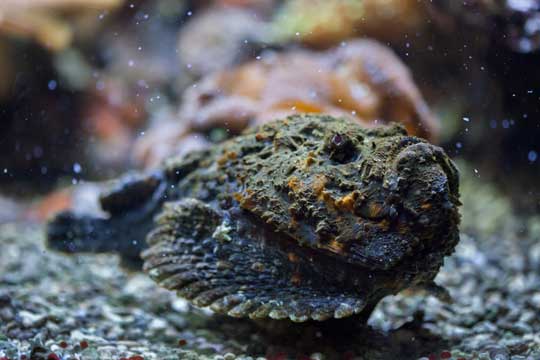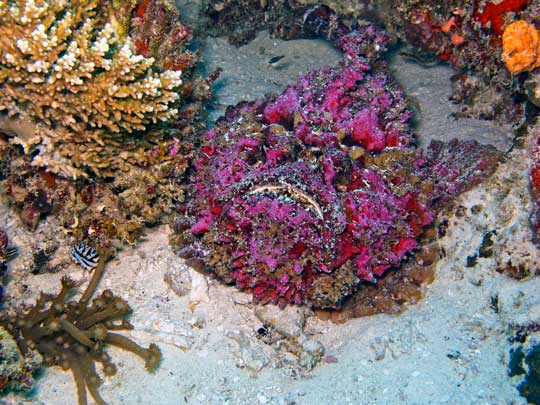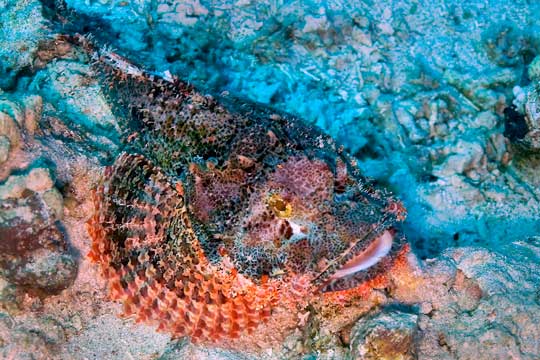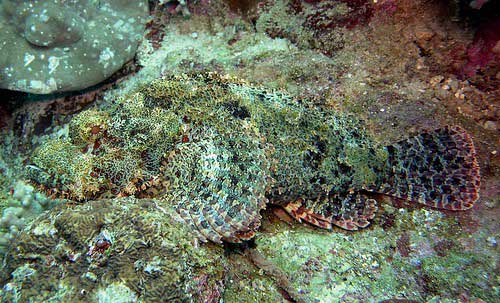|
I hope you don't mind, but I'm continuing this weird theme of featuring venomous animals. After all, being venomous is a rather fascinating adaptation for survival, don't you think? Did you know there are venomous fish? This is not to be confused with poisonous fish. Poisonous and venomous are not the same thing. Poison is a toxin that gets into the body by eating it, inhaling it, or absorbing it through the skin. Venom is a toxin that is injected, usually by fangs, a stinger, or some kind of barb. Very few (if any) snakes are poisonous, but some are venomous. Some plants are poisonous because they have toxins in their berries, leaves, or stems that will make you sick if you eat them. But they do not inject the toxins, so they are not venomous. Stonefish are the most venomous fish we know of. Their venom protects them from predators, and it is injected by the sharp spines of their dorsal fin. Masters of disguise, their bumpy skin and drab colors often make them look like an algae-covered stone. What the heck is a Stonefish? The stonefish include five species in the family Synanceiidae. They live mostly in coral reef waters in the Indo-Pacific (around Australia, New Guinea, Indonesia, and the Red Sea and Indian Ocean). These fish grow up to 20 inches (50 cm) long, and they have a huge, upturned mouth. They do not have scales, but their skin often has warty bumps and protrusions and filaments that look like algae growing on a rock. Even their eyes can look like algae. And these fish can change their colors to better blend in with whatever the surroundings look like at the time. Stonefish sit very still, often half buried in the sand, and wait for prey to wander by. Amazing Facts about Stonefish First, we need to talk about this fish's nasty habit of protecting itself with dangerous venom. Is it really the most venomous fish in the world? Yes, according to most sources. The venom is produced by special glands located at the base of each of the thirteen spines of the dorsal fin. The venom is conducted through ducts along each spine to the spine's sharp tip. Typically, these spines are hidden, covered by the camouflaged skin. But when the fish is alarmed, it erects its dorsal fin. If something (like a stingray's mouth or a human's foot) puts pressure on the fish, this forces the skin back, and the needle-like spines penetrate and inject the venom. The more pressure applied to the fish, the more venom is released. Stonefish venom is amazingly dangerous—it can even be fatal to humans if not treated properly with anti-venom. The results of a sting begin with agonizing pain and swelling, and bad stings can lead to necrosis, paralysis, and even heart failure. Most human stings occur when swimmers accidentally step on a stonefish. Australia has the highest number of stonefish stings, with about 25 cases per year that are bad enough to administer anti-venom. Human deaths are rare, probably because of the availability of anti-venom, but numerous swimmers suffer the pain of stings that do not warrant the use of anti-venom. Some aboriginal Australians have traditional ceremonies, called corroborees, in which they re-enact the events of one of their members stepping on a stonefish and dying from the sting. This is a traditional way of teaching their children about the dangers of this fish. The stonefish uses its venom only as a defense, never for killing or capturing prey. I suppose that makes sense... how could a stonefish possibly jab the spines in the middle of its back into a fish it is trying to catch? Stonefish are obviously well camouflaged, but this is mainly to help them ambush prey. They still get attacked by predators, particularly sharks, stingrays, and sea snakes. That's when their venom helps protect them. We don't know this for sure, but it is thought that sea snakes are immune to stonefish venom. Sea snake venom, however, is dangerous to stonefish, and after a sea snake bites, the stonefish becomes immobile, and the sea snake can swallow it without the fish's spines sticking up and getting in the way or causing damage. Stonefish may spend most of their time sitting still and waiting, but when a prey fish or shrimp comes along, the attack comes really fast. They can grab and swallow the prey in as little as 0.015 second! Check out this video about stonefish attacking prey. Stonefish sometimes get stranded out of water, completely or partially, at low tide. This usually isn't a problem for them, though, because they can survive for up to 24 hours by absorbing oxygen through their skin. As a result, many of the human stings actually occur on the beach instead of in the water. It's easy to imagine how this could happen—among the exposed coral stones at low tide, a stonefish would be difficult to spot. Stonefish are solitary animals, spending most of their lives alone except when it is time to mate. When a male finds a receptive female, the female releases her eggs into the water. The male then swims over the eggs and releases sperm onto them. The eggs hatch in only three days, but the young are vulnerable to predators and few of them survive. Stonefish venom is a protein, so it breaks down when heated. If properly cooked, these fish can be eaten by people and are considered a delicacy in many parts of Asia. Actually, they are often eaten raw, although—not surprisingly—the dorsal spines are carefully removed beforehand. So, the Stonefish deserves a place in the N.U.A.H.O.F. (Numero Uno Animal Hall of Fame). FUN FACT: The phrase numero uno literally means number one. The phrase was borrowed from Italian into English in the early 1970s. In Spanish, número uno means the same thing and is pronounced the same. Typically, in the English language, it has been used the same way number one is used, and is often used to refer to oneself or one's best interests, as in "He's always looking out for numero uno." It is also used to refer to someone or something that is ranked highest, as in "The Kansas City Chiefs are numero uno." Finally, the phrase is often used as an adjective to describe anything or anyone that is impressive or best at something, as in "The stonefish is the numero uno venomous fish in the world." So, more or less, numero uno is another way to say awesome! Photo Credits:
- Stonefish #1, gray and orange - DepositPhotos - Stonefish #2, with purple splotches - DepositPhotos - Stonefish #3, orange and red, with fins spread - DepositPhotos - Stonefish #4, facing to the left - "Stonefish 33" by High Desert Rider, licensed under CC BY-NC-ND 2.0
0 Comments
Leave a Reply. |
Stan's Cogitations
Everyone needs a creative outlet. That's why I write. Archives
July 2024
|





 RSS Feed
RSS Feed